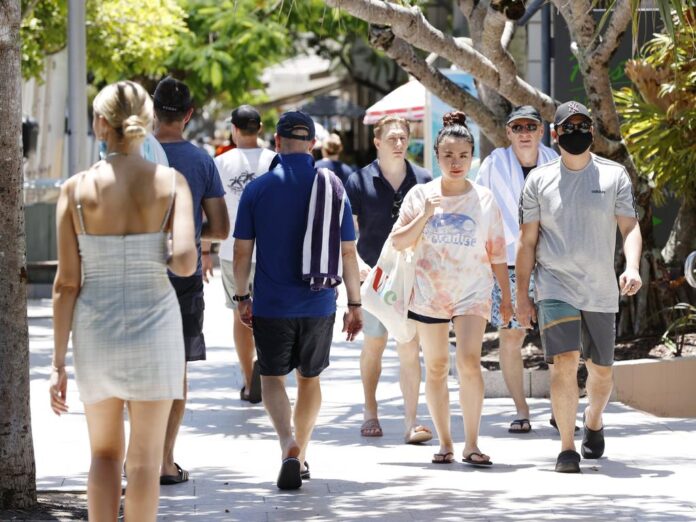[ad_1]
QUEENSLAND remains the destination of choice with one region dominating the field.
The Sunshine Coast has surged ahead as Australia’s most coveted region for movers, capturing a record share of net internal migration over the last year according to the latest
Regional Movers Index (RMI).
But it has competition, with regional Western Australia’s also gaining popularity, particularly with metro movers.
Shoppers on Hastings street in Noosa. Picture Lachie Millard
The RMI, in partnership between Commonwealth Bank of Australia (CBA) and the Regional Australia Institute (RAI), analyses the quarterly and annual trends in people moving to and from Australia’s regional areas.
Data from the just-released December 2023 quarter RMI shows the net internal migration index to the regions increased by 4.6 per cent over the last three months — it’s highest level since the September 2022 quarter and 13.8 percent above the pre-Covid average.
This index measures the number of people moving into the regions, relative to the number of people moving back to our capital cities.
RAI CEO Liz Ritchie said the lure of regional living remains strong, with 24.9 per cent more people moving from the city to the regions, than back in the opposite direction.
“Regional Australia offers something more for many people, especially those from big cities. More space, more time, more affordability,” she said.
“This shift, away from capital city living, has been underway now for a decade. It was definitely supercharged by Covid, but this data proves the regions are still very desirable for a significant proportion of the population.” .
Regional Australia Institute CEO Liz Ritchie. PIcture: Bill Conroy
Sydney was again the capital that shed the most people in the last 12 months, accounting for 65 per cent of all capital city outflows, followed by Melbourne at 35 per cent.
Here comes the boom: Townsville property market set to heat up
Restored Townsville heritage home commands attention
The 20 words that could sell your home
Regional New South Wales also accounted for the largest share of net inflows from capitals, capturing 36 per cent of all city dwellers leaving the big smoke, followed by regional Queensland at 32 per cent and regional Victoria at 30 per cent.
The Sunshine Coast, Gold Coast, Greater Geelong (Vic), Moorabool (Vic) and Fraser Coast all made return appearances in the RMI’s regional hotspot list, by share of net internal migration.
Makes total sense! Aerial view of the stunning Gold Coast skyline on a sunny day, Queensland, Australia
However, the Sunshine Coast now commands an impressive lead, accounting for a 17.5 per cent share of all net internal migration, up from 12.5 per cent a year ago, and eclipsing the next most attractive region, the Gold Coast, which has an 8.1 per cent share.
Commonwealth Bank executive general manager regional and agribusiness banking Paul Fowler said the Sunshine Coast was one of Queensland’s fastest-growing economies, so it was no surprise it had retained its coveted number one spot for the fifth quarter in a row.
“A skilled and diverse labour supply is one of the most critical inputs for any economy and Sunshine Coast businesses across a wide range of sectors are taking advantage of the growth in people coming to the area, moving at pace to explore new and innovative opportunities,” Mr Fowler said.
Mr Fowler said when it comes to growth hotspots, Western Australia continues to grow.
“WA’s economy is strengthening beyond traditional resources, with wholesale trade, construction, professional services and agribusiness coming to the fore,” Mr Fowler said.
Ms Ritchie added Western Australia was a standout performer in two key measures – taking out three of the top-five spots for annual growth in both total net internal migration and net capital-to-regional migration.
“In the last 12 months the Shire of Boddington has seen a 219 per cent increase in net internal migration – with more than 70 per cent of the movers made up of Millennials and Gen Xers and almost all of those relocating to the area from Perth.”
Despite this, capital to regional migration remains 2.1 per cent above the pre-Covid average.
[ad_2]
Source link


